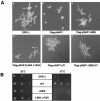Involvement of nucleocytoplasmic shuttling of yeast Nap1 in mitotic progression
- PMID: 12944491
- PMCID: PMC193709
- DOI: 10.1128/MCB.23.18.6672-6684.2003
Involvement of nucleocytoplasmic shuttling of yeast Nap1 in mitotic progression
Abstract
Nucleosome assembly protein 1 (Nap1) is widely conserved from yeasts to humans and facilitates nucleosome formation in vitro as a histone chaperone. Nap1 is generally localized in the cytoplasm, except that subcellular localization of Drosophila melanogaster Nap1 is dynamically regulated between the cytoplasm and nucleus during early development. The cytoplasmic localization of Nap1 is seemingly incompatible with the proposed role of Nap1 in nucleosome formation, which should occur in the nucleus. Here, we have examined the roles of a putative nuclear export signal (NES) sequence in yeast Nap1 (yNap1). yNap1 mutants lacking the NES-like sequence were localized predominantly in the nucleus. Deletion of NAP1 in cells harboring a single mitotic cyclin gene is known to cause mitotic delay and temperature-sensitive growth. A wild-type NAP1 complemented these phenotypes while nap1 mutant genes lacking the NES-like sequence or carboxy-terminal region did not. These and other results suggest that yNap1 is a nucleocytoplasmic shuttling protein and that its shuttling is important for yNap1 function during mitotic progression. This study also provides a possible explanation for Nap1's involvement in nucleosome assembly and/or remodeling in the nucleus.
Figures








Similar articles
-
A beta-hairpin comprising the nuclear localization sequence sustains the self-associated states of nucleosome assembly protein 1.J Mol Biol. 2008 Jan 25;375(4):1076-85. doi: 10.1016/j.jmb.2007.11.031. Epub 2007 Nov 19. J Mol Biol. 2008. PMID: 18068721 Free PMC article.
-
Phosphorylation by casein kinase 2 regulates Nap1 localization and function.Mol Cell Biol. 2008 Feb;28(4):1313-25. doi: 10.1128/MCB.01035-07. Epub 2007 Dec 17. Mol Cell Biol. 2008. PMID: 18086883 Free PMC article.
-
NBP1 (Nap1 binding protein 1), an essential gene for G2/M transition of Saccharomyces cerevisiae, encodes a protein of distinct sub-nuclear localization.Gene. 2000 Apr 4;246(1-2):395-404. doi: 10.1016/s0378-1119(00)00067-6. Gene. 2000. PMID: 10767562
-
[Physiological functions of the acidic molecular chaperone Nap1].Seikagaku. 2005 Mar;77(3):206-12. Seikagaku. 2005. PMID: 15835307 Review. Japanese. No abstract available.
-
Nuclear export of ribosomal subunits.Trends Biochem Sci. 2002 Nov;27(11):580-5. doi: 10.1016/s0968-0004(02)02208-9. Trends Biochem Sci. 2002. PMID: 12417134 Review.
Cited by
-
NAP1 family histone chaperones are required for somatic homologous recombination in Arabidopsis.Plant Cell. 2012 Apr;24(4):1437-47. doi: 10.1105/tpc.112.096792. Epub 2012 Apr 24. Plant Cell. 2012. PMID: 22534127 Free PMC article.
-
KSHV encoded LANA recruits Nucleosome Assembly Protein NAP1L1 for regulating viral DNA replication and transcription.Sci Rep. 2016 Sep 7;6:32633. doi: 10.1038/srep32633. Sci Rep. 2016. PMID: 27599637 Free PMC article.
-
Interacting proteins and differences in nuclear transport reveal specific functions for the NAP1 family proteins in plants.Plant Physiol. 2005 Jul;138(3):1446-56. doi: 10.1104/pp.105.060509. Epub 2005 Jun 24. Plant Physiol. 2005. PMID: 15980199 Free PMC article.
-
MoNap1, a Nucleosome Assemble Protein 1, Regulates Growth, Development, and Pathogenicity in Magnaporthe oryzae.J Fungi (Basel). 2022 Dec 28;9(1):50. doi: 10.3390/jof9010050. J Fungi (Basel). 2022. PMID: 36675871 Free PMC article.
-
Tsr4 and Nap1, two novel members of the ribosomal protein chaperOME.Nucleic Acids Res. 2019 Jul 26;47(13):6984-7002. doi: 10.1093/nar/gkz317. Nucleic Acids Res. 2019. PMID: 31062022 Free PMC article.
References
-
- Aalfs, J. D., and Kingston, R. E. 2000. What does ‘chromatin remodeling’ mean? Trends Biochem. Sci. 25:548-555. - PubMed
-
- Adams, C. R., and R. T. Kamakaka. 1999. Chromatin assembly: biochemical identities and genetic redundancy. Curr. Opin. Genet. Dev. 9:185-190. - PubMed
-
- Bortvin, A., and F. Winston. 1996. Evidence that Spt6p controls chromatin structure by a direct interaction with histones. Science 272:1473-1476. - PubMed
Publication types
MeSH terms
Substances
LinkOut - more resources
Full Text Sources
Other Literature Sources
Molecular Biology Databases
Research Materials
Miscellaneous
